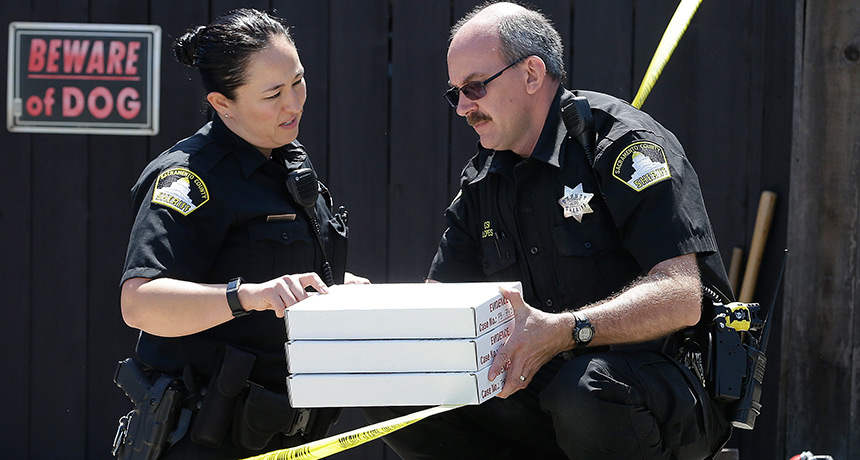How we reported on the challenges of using ancestry tests to solve crimes

GATHERING EVIDENCE Crime scene investigators from the Sacramento County Sheriff’s office collected boxes of evidence from the home of Golden State Killer suspect Joseph DeAngelo. The case against DeAngelo was built on DNA evidence, including some new genetic sleuthing techniques.
Rich Pedroncelli/Associated Press
- More than 2 years ago
This is part of the Transparency Project, which explains how we do science journalism. This article refers to a story published in April 2018, “New genetic sleuthing tools helped track down the Golden State Killer suspect.”
I was in the midst of writing a series on consumer DNA testing when news broke that police had arrested a suspect in the Golden State Killer case. Investigators had reportedly used an ancestry database to track the man down, and speculation was that either AncestryDNA or 23andMe, two popular direct-to-consumer testing companies, had turned over customer data to the police. Both companies denied involvement.
Because I was deep into do-it-yourself DNA analysis at that point, I knew about a genealogy site called GEDMatch. There, people can upload raw DNA data from one company to find relatives that tested with different companies. Police confirmed to the Sacramento Bee that they had used the site in the investigation.
But I also knew that the type of DNA police usually collect doesn’t match the type of data generated by DNA testing companies. I wanted to know the science behind the investigation.
Here’s how I found out what happened.
First, I contacted the law enforcement agencies involved, but got no response to my queries. So I turned to an unusual resource — my editor’s brother, Billy Jensen. That’s not something news reporters generally do. Our friends and family are not sources of information because it could be a conflict of interest. But Jensen had a special link to this case. He is an investigative journalist and amateur crime solver who helped to finish Michelle McNamara’s book I’ll Be Gone in the Dark, about the serial killer who terrorized California in the 1970s and 1980s.
Jensen connected me to Colleen Fitzpatrick and Margaret Press of the DNA Doe Project. The project has been using genetic genealogy to identify human remains, a process very similar to what the police would have done to find their suspect. Press and Fitzpatrick were instrumental in laying out the process of turning crime scene DNA into data that could be uploaded to GEDMatch, so I could explain it clearly and accurately.
Next, I wanted to know what this type of investigative technique could mean for the privacy of the millions of people who have had their DNA tested through DIY kits. So I contacted Alondra Nelson, a professor of sociology at Columbia University and author of the book “The Social Life of DNA: Race, Reparations and Reconciliation after the Genome,” to give me her perspective. We had time for only a brief conversation and I felt there was more to explore. In all my stories I seek out a variety of opinions. I also contacted Sara Katsanis, a former forensic DNA analyst who is an instructor at Duke University, and Katie Hasson program director for genetic justice at the Center for Genetics and Society. I chose them because both think deeply about DNA in the legal system and genetic privacy on a daily basis as part of their jobs. I didn’t know that they would have such different takes on the matter. I included excerpts from both interviews because each brought up points I thought readers deserved to hear.
Read the April 2018 story here.
 |
Tina Hesman Saey is the molecular biology reporter and senior staff writer for Science News. She has a Ph.D. in molecular genetics from Washington University in St. Louis and a master’s in science journalism from Boston University. Tina previously covered biotechnology, genetics and medical science for the St. Louis Post-Dispatch. Read more » | |
| About this bio | ||
 | |
| Tina Hesman Saey is the molecular biology reporter and senior staff writer for Science News. She has a Ph.D. in molecular genetics from Washington University in St. Louis and a master’s in science journalism from Boston University. Tina previously covered biotechnology, genetics and medical science for the St. Louis Post-Dispatch. Read more » | |
| About this bio | |







